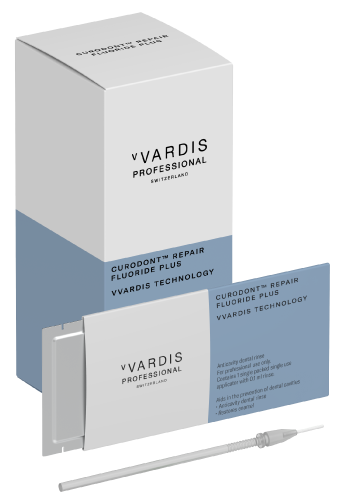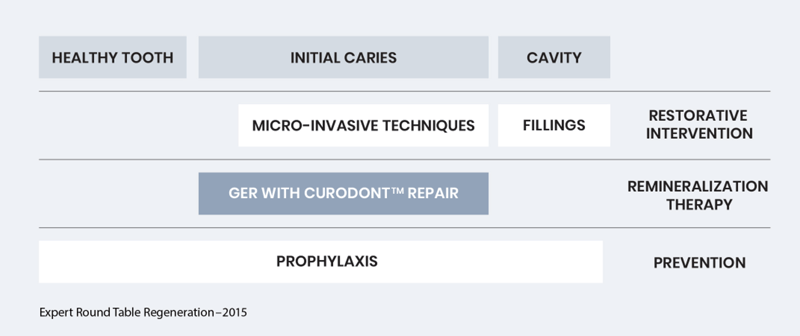Curodont™ Repair Fluoride Plus
TREAT EARLY CARIES
WITH NO DRILLING
OR FILLING


Rebuild and Repair at the First Signs of Breakdown
Parents and pediatric patients will appreciate early stage caries intervention without painful drilling or staining, while potentially avoiding years of costly and traumatic treatment.
Curodont™ Repair Fluoride Plus
Curodont Repair Fluoride Plus naturally rebuilds and repairs enamel at the first signs of breakdown. This non-invasive 5-minute chairside treatment uses a proprietary peptide to repair teeth naturally. Unlike fluoride, which only promotes remineralization on the tooth's surface, Curodont uses calcium, phosphate, and other minerals found in the patient's own saliva to rebuild down to the depth of the lesion.
Leverages amino acids to help new hydroxyapatite crystals grow.
Unlike other options on the market, Curodont does not stain or discolor the tooth surface.
Offers a 95% success rate* and 13X higher probability of success compared to fluoride varnish alone.**
Complement Your Care
Curodont™ Protect
Anti-cavity Dentifrice Gel for Sensitive Teeth
Curodont Protect is a remineralizing dental gel that aids in the prevention of dental cavities and builds increasing protection against painful tooth sensitivity.
Its proprietary formulation, which features stabilized stannous fluoride combined with Curodont technology, remineralizes and strengthens the enamel while offering relief from sensitivity.
Curodont Protect is the ideal complement to treatment with Curodont Repair Fluoride Plus; its daily application at home after the in-office treatment with Curodont Repair Fluoride Plus fosters patient compliance and engagement with the treatment, while helping to maximize outcomes.
*Godenzi, D. (2018) “Give Teeth a Chance: Curodont Repair in daily practice” Lecture at EAPD, Lugano, Switzerland 2018
**Kind, L., et al (2017) “Biomimetic Remineralization of Carious Lesions by Self-Assembling Peptide.” J Dent Res 96(7): 790-797
"Curodont™ Repair Fluoride Plus offers a pivotal opportunity at the threshold between preventative and restorative interventions: time is on your side – remineralize incipient tooth decay, filling instead of drilling.”
Dr. Volker Scholz
How It Works
Using a proprietary self-assembling peptide, Curodont begins to remineralize target enamel within 5 minutes of application and continues strengthening it in the weeks following treatment. The unique formula penetrates deep into the depth of the lesion where it leverages calcium and phosphate from patient saliva to help new hydroxyapatite grow.
Radiographic changes are visible within 3-6 months. To optimize outcomes, Curodont can be applied several times at intervals of 3-6 months between each application and can also be combined with fluoride treatment.
“Curodont™ Repair Fluoride Plus is the first brush on treatment for tooth decay that does not require a needle, nor a drill, does not stain and does not taste bad.”
Jeremy Horst Keeper, DDS, PhD
Guided Enamel Remineralization
Guided Enamel Remineralization (GER) bridges the gap between prevention and invasive restorative approaches to treat initial carious lesions and white spots. Curdont™ Repair Fluoride Plus enables in-depth remineralization of the enamel while maintaining the integrity of the tooth.

Studies and Supporting Literature
- Alkilzy, M. et al (2018) “Self-assembling Peptide P11-4 and Fluoride for Regenerating Enamel.” J Dent Res (97): (2018) 148
- Barbosa-Martins, L. F. et al (2018) “Enhancing bond strength on demineralized dentin by pre-treatment with selective remineralising agents.» J Mech Behaviour Biomedical Materials https://doi.org/10.1016/j.jmbbm.2018.03.007
- Barbosa-Martins, L. F. et al (2018) “Biomimetic Mineralizing Agents Recover the Micro Tensile Bond Strength of Demineralized Dentin» Materials 2018, 11, 1733; doi:10.3390/ma11091733
- Bröseler, F. et al (2019) “Randomised clinical trial investigating self-assembling peptide P11-4 in the treatment of early caries.” Clin Oral Invest, https://doi.org/10.1007/s00784-019-02901-4
- Brigi, C. (2014) “In vitro measurement of dental remineralisation: investigating a biomimetic self-assembling peptide treatment strategy” Master Thesis, Queen Mary, University of London.
- Brubaker, L. et al. (2016) “Remineralization of Early-Enamel Lesions Using Biomimetic Regeneration Combined With Fluoride-toothpaste” AADR Abstract 1809, Los Angeles, USA.
- Brunton, PA., et al, (2013) “Treatment of early caries lesions using biomimetic self-assembling peptides – a clinical safety trial” Brit Dent J, 2013, 215: E6
- Davies, R.P.W. et al, (2015) “Treatment of Fabricated Caries Lesions; Self-Assembling Peptides vs Fluoride. Abstract 143” Caries Res (49): (2015): 359
- Doberdoli, D. et al (2020) “Randomized Clinical Trial investigating Self-Assembling Peptide P11-4 for Treatment of Early Occlusal Caries” Scientifc Rep https://doi:10.1038/s41598-020-60815-8
- Godenzi, D. (2018) “Give Teeth a Chance: Curodont Repair in daily practice” Lecture at EAPD, Lugano, Switzerland 2018
- Jablonski-Momeni, A. & Heinzel-Gutenbrunner M. (2014) “Efficacy of the “Self-assembling peptide P11-4” in the formation of a remineralization scaffold on artificially induced enamel lesions on smooth surfaces.” J Orofac Orthop, 75 (3): 175-190
- Jablonski-Momeni, A. et al (2020) “Impact of self-assembling peptides in remineralisation of artificial early enamel lesions adjacent to orthodontic brackets” Sci Rep 10, 15132 (2020)
- Kamal, D. et al (2018) “Comparative evaluation of remineralizing efficacy of biomimetic self-assembling peptide on artificially induced enamel lesions: An in vitro study” J Conserv Dent 21:536-41
- Kamal, D. et al (2020) ”Complementary remineralizing effect of self-assembling peptide (P11-4) with CPP-ACPF or fluoride: An in vitro study” J Clin Exp Dent 12(2): e161-8
- Kind, L., et al (2017) “Biomimetic Remineralization of Carious Lesions by Self-Assembling Peptide.” J Dent Res 96(7): 790-797.
- Kirkham, J., et al. (2007). “Self-assembling peptide scaffolds promote enamel remineralisation.” J Dent Res 86(5): 426-430.
- Knaup, T., et al (2020) “Effect of the caries-protective self-assembling peptide P11-4 on shear bond strength of metal brackets.” J Orofac Orthop https://doi.org/10.1007/s00056-020-00247-1
- Kobeissi, R. et al (2020) “Effectiveness of Self-assembling Peptide P11-4 Compared to Tricalcium Phosphate Fluoride Varnish in Remineralization of White Spot Lesions: A Clinical Randomized Trial.”Int J Clin Pediatr Dent. 2020;13(5):451-456. doi:10.5005/jp-journals-10005-1804
- Kucukyilmaz, E. et al. (2016) “Measuring the remineralization potential of different agents with quantitative light-induced fluorescence digital Biluminator” J Appl Biomater Funct Mater DOI: 10.5301/jabfm.5000317
- Moreira, KMS. et al (2021) “Impact of biomineralization on resin/biomineralized dentin bond longevity in a minimally invasive approach: An “in vitro” 18-month follow-up” Dental Materials doi.org/10.1016/j.dental.2021.01.021.
- Patel, S. et al. (2016). “In Vitro Assessment of a Novel Biomimetic-Regeneration of Early Caries Lesions.” AADR Abstract 1808, Los Angeles, USA.
- Schlee, M. et al. (2017). “Clinical performance of self-assembling peptide P11-4 in the treatment of initial proximal carious lesions: A practice-based case series.” J Invest Clin Dent: DOI: 10.1111/jicd.12286.
- Schlee, M. et al. (2014). “ Klinischer Effekt biomimetischer Mineralisation bei Approximalkaries.” Stomagologie 111(4-5):175-181.
- Schmidlin, P. et al. (2016). “In vitro re-hardening of artificial enamel caries lesions using enamel matrix proteins or self-assembling peptides.” J Appl Oral Sci 24(1):31-36
- Sedlakova Kondelova, P. et al (2020). “Efficacy of P11-4 for the treatment of initial buccal caries: a randomized clinical trial.” Sci Rep 10(1): 20211
- Sezici, Y., et al. (2021) “Comparative evaluation of fluoride varnishes, self-assembling peptide-based remineralization agent, and enamel matrix protein derivative on artificial enamel remineralization in vitro.” Prog Orthod. 22, 4 (2021). https://doi.org/10.1186/s40510-020-00345-1
- Silvertown JD, et al. (2017). “Remineralization of natural early caries lesions in vitro by P11-4 monitored with photothermal radiometry and luminescence.” J Invest Clin Dent. 017;00:e12257. doi:10.1111/jicd.12257.
- Sindhura, V. et al (2018). “Evaluation of enamel remineralizing potential of self-assembling peptide P11-4 on artificially induced enamel lesions in vitro.” J Indian Soc Pedod Prev Dent, 36(4) 352-356.
- Suda, S., et al. (2018). “Application of the Self-Assembling Peptide P11-4 for Prevention of Acidic Erosion” Operative Dentistry, DOI: 10.2341/17-175-L
- Takahashi, F. et al (2016). “Ultrasonic assessment of the effects of self-assembling peptide scaffolds on preventing enamel demineralization.” Acta Odontol Scand (74): 142-7
- Takahashi, H. et al (2016). “Evaluation of Application of Peptide P11-4 on Remineralization of Enamel.” AADR Abstract 1804, Los Angeles, USA.
- Takahashi, F. et al (2017). “Application of the Self-assembling Peptide P11-4 on Acid Erosion Prevention» IADR Abstract, San Francisco, USA
- Üstün, N. & Aktören, O. (2019). “Analysis of efficacy of the self-assembling peptide-based remineralization agent on artificial enamel lesions.” Microsc Res Tech DOI: 10.1002/jemt.23254.
- Welk, A. et al (2020). “Effect of self-assembling peptide P11-4 on orthodontic treatment-induced carious lesions.” Scientific Rep https://doi.org/10.1038/s41598-020-63633-0
“I use Curodont™ Repair Fluoride Plus because I want to be the doctor who can treat early caries – without a syringe or drill. And I can assure: This is the greatest process optimization of all.”
Dr. Justin Rashbaum
Curodont Repair Fluoride Plus is a one application, 5-minute, professional chairside treatment designed to remineralize and repair early stage decay.
Curodont Repair Fluoride Plus should be used on non-cavitated, incipient lesions, with an ICDAS score of 1-3. It's appropriate for interproximal, occlusal, buccal, facial and lingual surfaces and suitable for patients 4 years and older. It can also be used during or after orthodontic bracketing.
When applied correctly, Curodont Repair Fluoride Plus penetrates deep into the depth of an early carious lesion. Its unique formulation builds a matrix that attracts calcium and phosphate from patient saliva to help de novo hydroxyapatite crystals grow - the essential component of strong, intact enamel. The formula begins to remineralize and repair early stage decay within 5 minutes of treatment and continues to reharden and repair the treated area during the weeks and months following treatment. Radiographic changes are visible in 3-6 months.
In the vast majority of cases, an early carious lesion, also known as an incipient or white spot lesion, that is not treated and is simply "watched" will progress into a cavitated lesion requiring restorative treatment. Most fillings have a life expectancy of 10-15 years and require replacement when additional decay forms around the margins or the restoration breaks down. Treating early lesions with Curodont before they cavitate can help prevent the need for a lifetime of costly restorative work. Curodont can be especially beneficial for interproximal lesions that would require the removal of healthy tissue to address decay.
No. Other means promoting remineralization such as fluoride varnish, may provide additional support for the regeneration of hard tooth structure.
Fluoride containing products promote remineralization and acid resistance solely on the tooth surface. Curodont Repair Fluoride Plus uses a proprietary self-assembling peptide and application procedure to penetrate deep into the depth of the lesion where it supports the growth of de novo hydroxyapatite.
Yes. While most carious lesions see a 95%** success rate, the procedure can be repeated if necessary.
No. Unlike other treatments for early stage decay, Curodont Repair Fluoride Plus does not stain any part of the treatment area.
2260 Wendt St
Algonquin, IL 60102
800-558-6684


